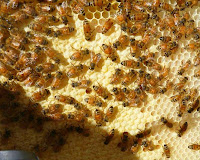When looking at these numbers, bare in mind that all these fruit trees are about or less than four years of age and that I raised all the veggies from seeds and - obviously - did not know yet quite when to plant what in SoCal. I am planning on being much more intime with the planting schedule for our region (now that I know the times of the season out here a tad better) for the next year to turn out more produce.
Anywho, given all the obstacles (off-timing, inexperienced us, aphids, spider mites, cabbage catterpillars, leaf miners, heat wave, hungry featherheads, etc..), I am pretty happy with our harvest for this June.
June 2011 Harvest Tally:
1/2 lbs of mulberries (soo bummed that the season is over; they are too good!)
2 lbs of strawberries (bit by bit or I should say berry by berry from plant to mouth they went - this variety is just too good)
1/2 lbs of Arugula (it's a race: who is faster me or the snails?!)
4 lbs of salads (now we are waiting for the next batch to get ready!)
4 lbs of mustard leaves (gotta admit; mostly bird food)
6 lbs of chard (bummer - the birds got the best of it, the featherheads were simply faster than me)
40 lbs of zucchinis (everyone got to benefit: Aunt Diana, as well as old and new neighbors, even Roberto's patients got to enjoy them...)
6 lbs of savoy cabbage (Oh my...)
1 lbs of peaches (we have donut and white peaches - suhweet!)
1 lbs of red onions with shallots
5 lbs red cabbage
1 lbs of cucumbers (from seeds from Germany! Thanks Andrea, Gabi und Opa!)
1 lbs basil (and yes, I will make pesto verde!)
And 5 lbs of lavender flowers, which I am in the process of turning into essential oils, soaps and sachets.
A WHOOPING TOTAL OF 77 LBS OF PRODUCE!
As far as our project list goes, we were not too lazy either, here are the leftovers from our super large project list:
1 lbs of red onions with shallots
5 lbs red cabbage
1 lbs of cucumbers (from seeds from Germany! Thanks Andrea, Gabi und Opa!)
1 lbs basil (and yes, I will make pesto verde!)
And 5 lbs of lavender flowers, which I am in the process of turning into essential oils, soaps and sachets.
A WHOOPING TOTAL OF 77 LBS OF PRODUCE!
| Duck house left and chicken coop on the right. |
- Build Chicken Coop (done - check it out.... it is a gorgeous Spanish mansion with a stunning stained glass window, a separate door for the eggs and all)
- Build Animal Enclosure (almost done)
So, we came up with a couple more planting beds, since we have a lot of concrete on our property and so many more seedlings that want to be planted.
I am also planning to put the blueberries in one of them since their soil requirements are so much more acidic than our soil, which is more on the alkaline side and their growth has been stunted for a while now.
I am planning on redesigning the front yard, tearing out more lawn as well as moving some of our perennials around.
What else??? Well, the tomatoes are getting ready.... yumm!!! I heavy-pruned them yesterday and staked them.
The featherheads have already eaten almost all of the Swiss Chard. . . good for them!
And I am expecting our very first duck egg some time in the end of July or at the beginning of August. I am sure, when that happens, we will do the happy dance for the featherheads... Roberto says, he hopes our handicapped Big lays the first egg!
The bees have just gotten a new deep super. If they fill this one up again, Roberto wants to let them swarm! That's right: We are going to give back one if her 'lost children' to Mother Nature.
"Nature never says one thing and wisdom another." Decimus Junius Juvenalis









